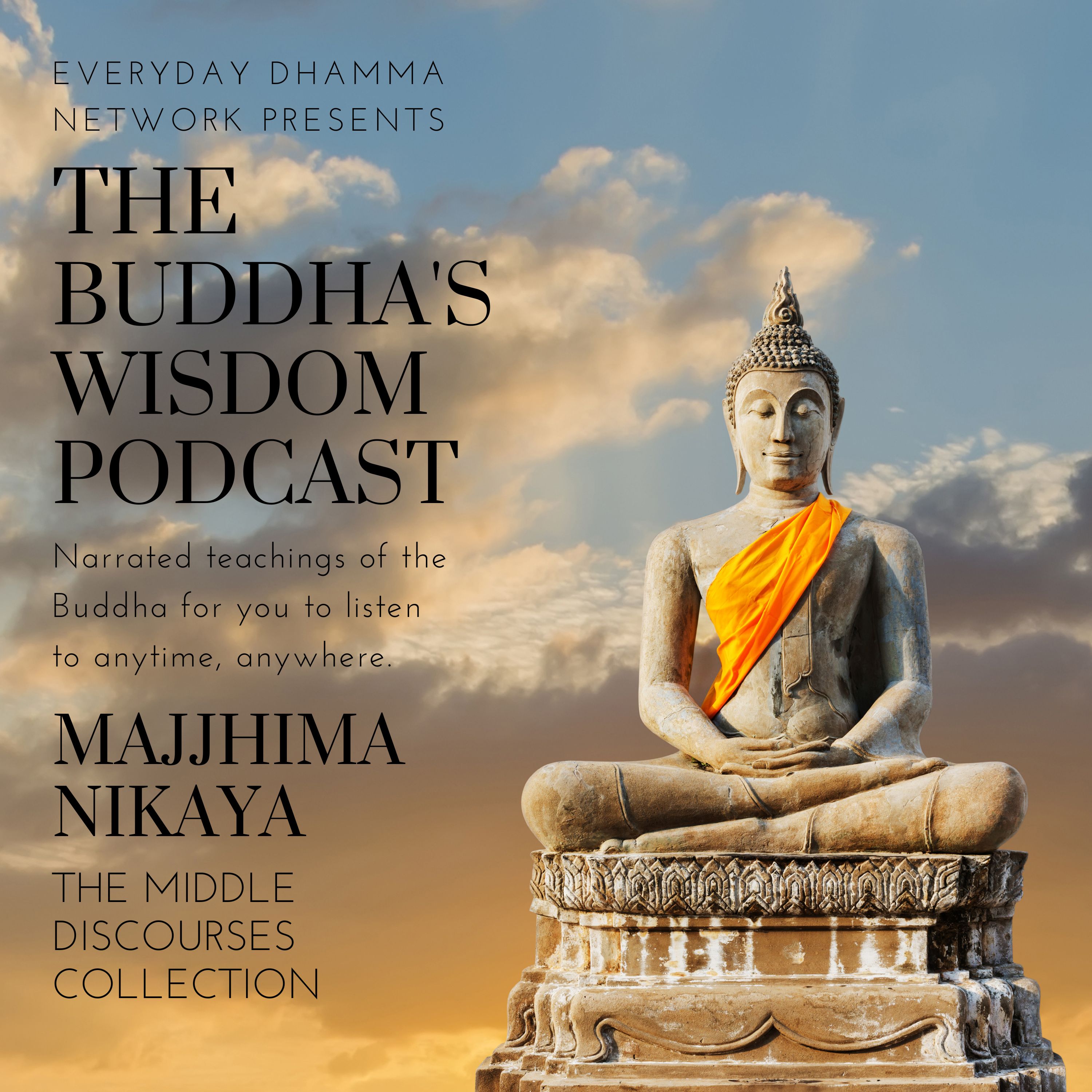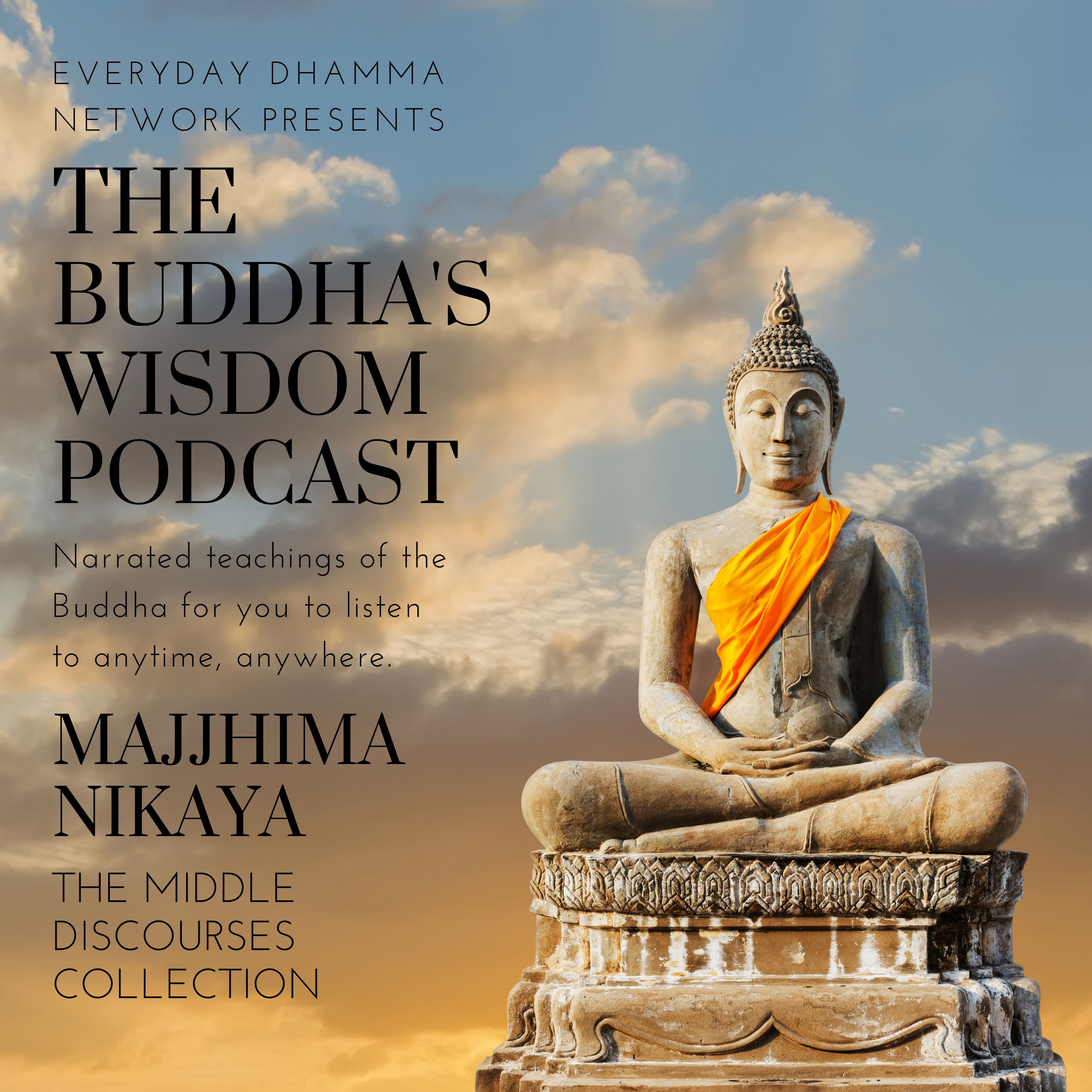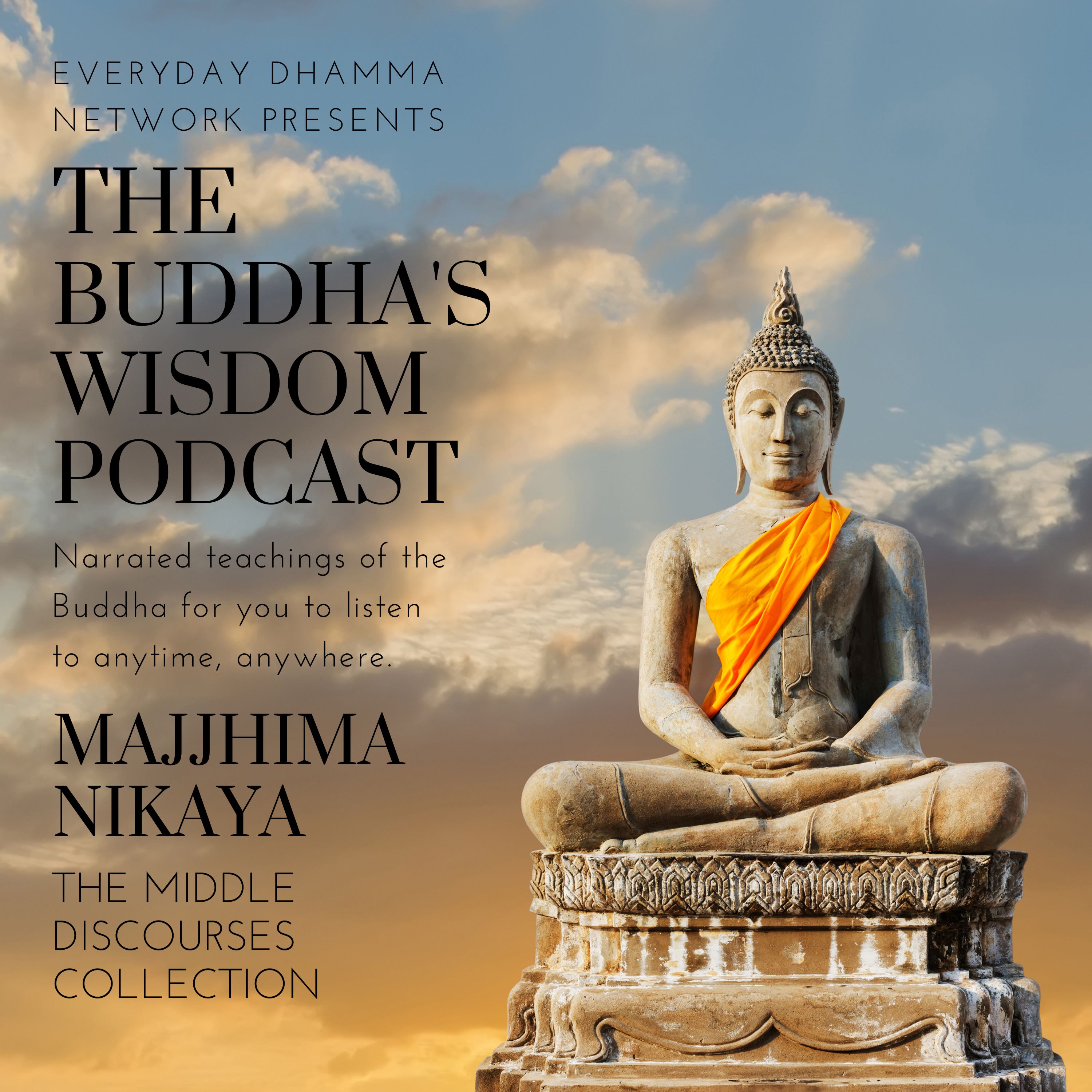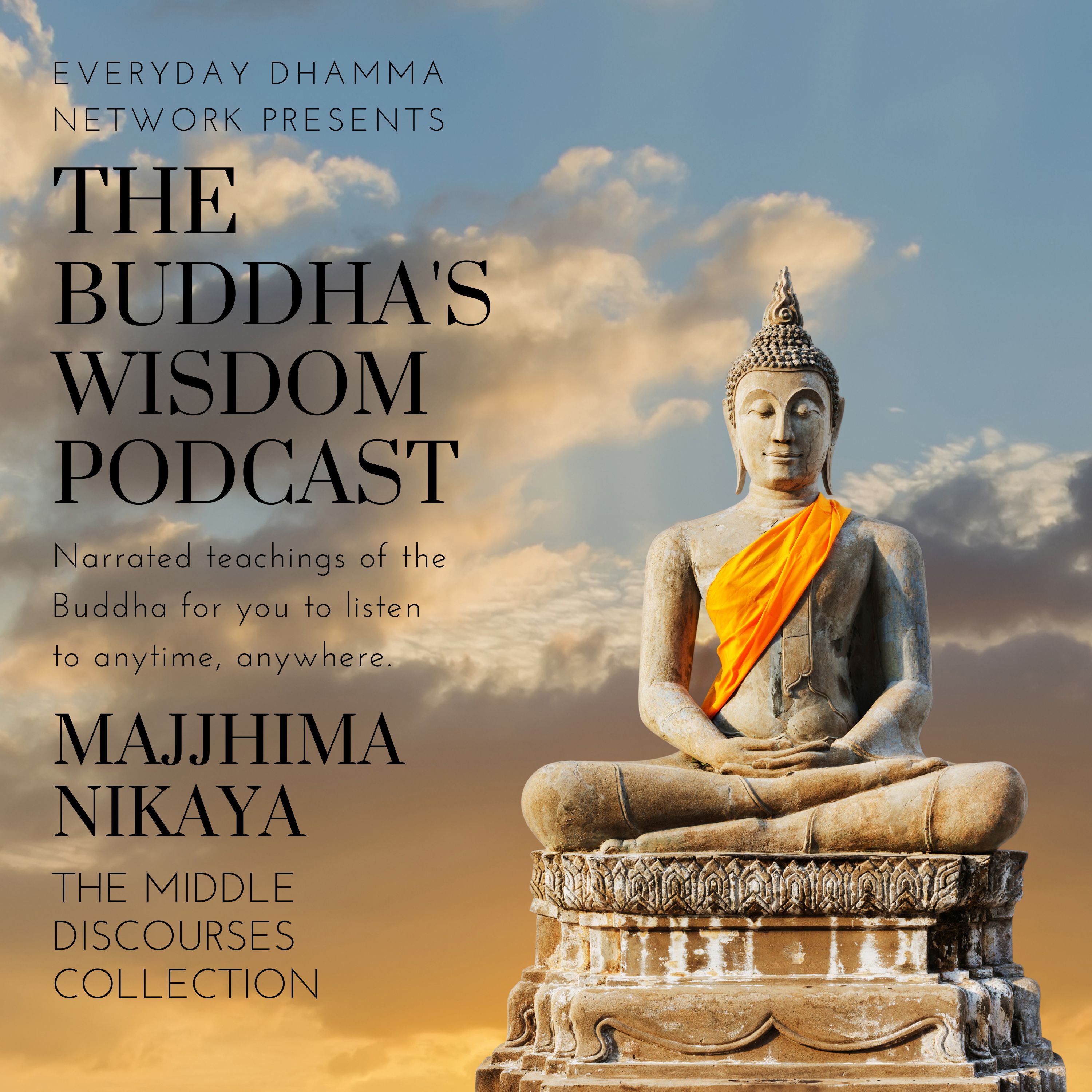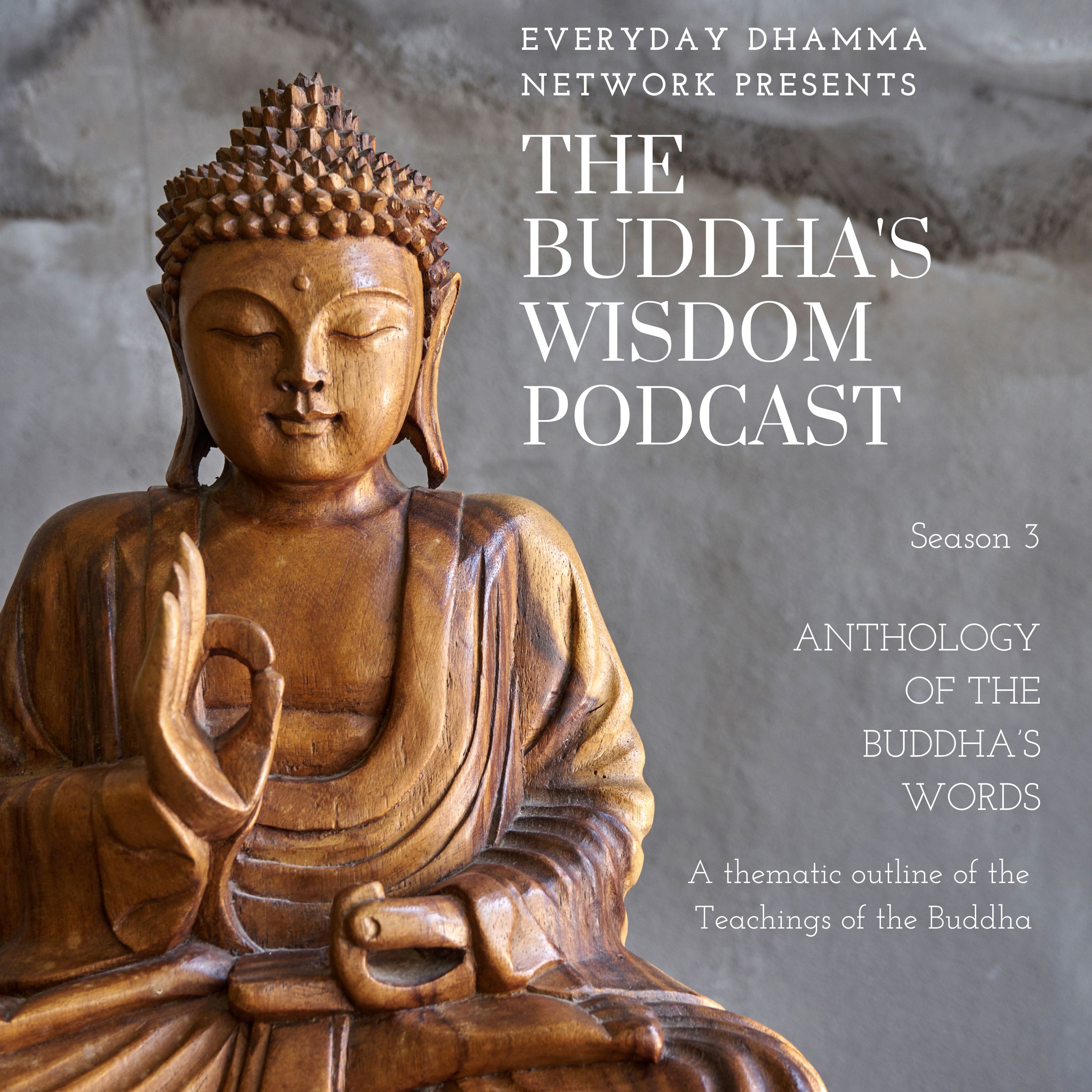Episode Transcript
The Shorter Elaboration
So I have heard. At one time the Buddha was staying near Rājagaha, in the Bamboo Grove, the squirrels’ feeding ground.
Then the layman Visākha went to see the nun Dhammadinnā, bowed, sat down to one side, and said to her: These two are little-known, in contrast with the previous vedalla featuring a dialogue between two mendicants renowned for their wisdom. | Dhammadinnā was recognized as the foremost bhikkhunī in teaching (AN 1.239:1.1), presumably on the basis of this sutta, and has a single verse to her name (Thig 1.12). | Visākha is otherwise unmentioned in the canon. The commentary says this is not the same person as the mendicant known as Visākha, Pañcāli’s son (Thag 2.45, AN 4.48, SN 21.7).
“Ma’am, they speak of this thing called ‘substantial reality’. The normal form of address for nuns is ayyā (“ma’am”), from the root ariya (“noble”); the masculine form ayya is occasionally used for monks as well. | “Substantial reality” is sakkāya, from sat (“real”) and kāya (“substance”). The Jain form is astikāya, which refers to the five fundamental substances (or ontological categories) comprised of the medium of motion, the medium of rest, space, soul, and matter (Bhagavatīsūtra 1.10). Note that the suttas use kāya, in the sense of “substance” or “mass”, as a key doctrinal term for ascetic movements associated with Jainism (eg. DN 2:23.3, DN 2:26.2), whereas kāya appears to have had no philosophical importance in pre-Buddhist Vedic texts. The commentaries define sakkāya as “the three planes of cyclic existence”, i.e. all that exists. Thus sakkāya is the “substantial reality” that is mistakenly assumed to be a “self”. What is this substantial reality that the Buddha spoke of?”
“Visākha, the Buddha said that these five grasping aggregates are substantial reality. Sāriputta also quotes the Buddha as saying this at SN 38.15:1.3, both sources apparently drawing from SN 22.105:1.5 and SN 22.103:1.6. That is, the grasping aggregates of form, feeling, perception, choices, and consciousness. The Buddha said that these five grasping aggregates are substantial reality.”
Saying “Good, ma’am,” Visākha approved and agreed with what Dhammadinnā said. Then he asked another question:
“Ma’am, they speak of this thing called ‘the origin of substantial reality’. What is the origin of substantial reality that the Buddha spoke of?”
“It’s the craving that leads to future lives, mixed up with relishing and greed, taking pleasure wherever it lands. That is, This treats “substantial reality” in terms of the four noble truths, a method also followed in multiple places such as AN 4.33:2.2, SN 22.103:1.4, SN 22.105:1.2, and SN 22.78:4.1. craving for sensual pleasures, craving to continue existence, and craving to end existence. The Buddha said that this is the origin of substantial reality.”
“Ma’am, they speak of this thing called ‘the cessation of substantial reality’. What is the cessation of substantial reality that the Buddha spoke of?”
“It’s the fading away and cessation of that very same craving with nothing left over; giving it away, letting it go, releasing it, and not clinging to it. The Buddha said that this is the cessation of substantial reality.”
“Ma’am, they speak of the practice that leads to the cessation of substantial reality. What is the practice that leads to the cessation of substantial reality that the Buddha spoke of?”
“The practice that leads to the cessation of substantial reality that the Buddha spoke of is simply this noble eightfold path, that is: right view, right thought, right speech, right action, right livelihood, right effort, right mindfulness, and right immersion.”
“But ma’am, is that grasping the exact same thing as the five grasping aggregates? Or is grasping one thing and the five grasping aggregates another?”
“That grasping is not the exact same thing as the five grasping aggregates. Nor is grasping one thing and the five grasping aggregates another. The desire and greed for the five grasping aggregates is the grasping there.” In the suttas, the five aggregates are not presented as a catch-all category that encompasses all of reality, but rather five types of phenomena that provoke attachment, forming the basis of what we take to be “self”. Desire is what drives the formation of attachment, but it requires all the aggregates to function. Thus the “grasping” aggregates are numbered “five” after the model of the hand that grasps.
“But ma’am, how does substantialist view come about?”
“It’s when an unlearned ordinary person has not seen the noble ones, and is neither skilled nor trained in the teaching of the noble ones. They’ve not seen true persons, and are neither skilled nor trained in the teaching of the true persons. They regard form as self, self as having form, form in self, or self in form. These are the twenty kinds of substantialist view. They regard feeling … perception … choices … consciousness as self, self as having consciousness, consciousness in self, or self in consciousness. That’s how substantialist view comes about.”
“But ma’am, how does substantialist view not come about?”
“It’s when a learned noble disciple has seen the noble ones, and is skilled and trained in the teaching of the noble ones. They’ve seen true persons, and are skilled and trained in the teaching of the true persons. They don’t regard form as self, self as having form, form in self, or self in form. They don’t regard feeling … perception … choices … consciousness as self, self as having consciousness, consciousness in self, or self in consciousness. That’s how substantialist view does not come about.”
“But ma’am, what is the noble eightfold path?”
“It is simply this noble eightfold path, that is: right view, right thought, right speech, right action, right livelihood, right effort, right mindfulness, and right immersion.”
“But ma’am, is the noble eightfold path conditioned or unconditioned?”
“The noble eightfold path is conditioned.”
“Are the three spectrums of practice included in the noble eightfold path? Or is the noble eightfold path included in the three practice categories?” This refers to the “three spectrums” of ethics, immersion, and wisdom (eg. AN 3.143:2.3). The shorthand reference to them as a group of three is characteristic of later strata of Pali, but it is also found at DN 10:1.6.1, and with the addition of vimutti at DN 33:1.11.145. | “Spectrum” here is khandha (elsewhere “aggregate”), which again has the same basic sense of “mass”, “category” as does kāya in sakkāya.
“The three spectrums of practice are not included in the noble eightfold path. Rather, the noble eightfold path is included in the three practice categories. The two teachings cover the same ground, but the more specific factors of the eightfold path are included in the more general categories of the three spectra. Right speech, right action, and right livelihood: these things are included in the spectrum of ethics. Right effort, right mindfulness, and right immersion: these things are included in the spectrum of immersion. Right view and right thought: these things are included in the spectrum of wisdom.”
“But ma’am, what is immersion? What things are the bases of immersion? What things are the prerequisites for immersion? What is the development of immersion?”
“Unification of the mind is immersion. “Unification” (ekaggatā), “immersion” (samādhi), and “absorption” (jhāna) are synonyms, although they may have specialized nuances. This understanding was common to Indic traditions, possibly under Buddhist influence. As just a few examples, Patañjali’s Yogasūtra 3.11 defines samādhi as unification, as does Śaṅkāra on Bṛhadāraṇyaka Upaniṣad 4.4.3 (aikāgryarūpeṇa samāhito), and the commentary to Bhagavad Gīta 2.42–44 (samādhiś cittaikāgryam) and 17.11 (samādhāyaikāgraṁ). The Jain Tattvārthasūtra 9.27 similarly defines dhyāna, as does the commentary to Bhagavad Gīta 4.27 (dhyānaikāgryam) and 13.24 (ekāgratayā yac cintanaṁ tad dhyānam). The four kinds of mindfulness meditation are the bases for immersion. The “foundations of immersion” (samādhinimittā) are the practices that lead to jhāna. Here nimitta means “cause” (Commentary: paccaya). The four right efforts are the prerequisites for immersion. Success in mindfulness meditation is the immediate cause of immersion, but to achieve both mindfulness and immersion it is a prerequisite (parikkhāra) to make an effort. The cultivation, development, and making much of these very same things is the development of immersion.” “Development” (bhāvanā) means “growing”, “amplifying”.
“How many processes are there?”
“There are these three processes. Physical, verbal, and mental processes.” These “processes” (saṅkhārā) apply, as we shall see, in the development of meditation (SN 41.6:1.5, DN 18:24.1). They must be distinguished from the similarly named three kinds of “choices” (saṅkhārā) that define volitional activity determining rebirth (i.e. karma, MN 57:8.2). In the three “processes”, the final item is always cittasaṅkhāra (“mental process”), whereas in the three “choices” the final item is usually manosaṅkhāra. While mano and citta both mean “mind”, mano leans to the sense of “volition”, while citta leans to the sense of “awareness”. It is a quirk of the Pali texts that they usually have cittasaṅkhāra in the context of dependent origination (but see SN 12.25:13.1), where the Sanskrit has the expected manaḥsaṁskāraḥ (SF 165 Ādisūtra, Arv 5.2 Arthaviniścayasūtra, SF 238 Pratītyasamutpādādivibhaṅganirdeśa).
“But ma’am, what is the physical process? What’s the verbal process? What’s the mental process?”
“Breathing is a physical process. Placing the mind and keeping it connected are verbal processes. Perception and feeling are mental processes.”
“But ma’am, why is breathing a physical process? Why are placing the mind and keeping it connected verbal processes? Why are perception and feeling mental processes?”
“Breathing is physical. It’s tied up with the body, that’s why breathing is a physical process. Breathing is referred to as a “physical process” in the context of breath meditation to emphasize the natural stilling that occurs as the meditation settles. | As in MN 43, the questions are laying the groundwork for a discussion of deep meditation. Hence in these definitions what is being discussed is not “processes” in general, but the very last residue of activity or disturbance whose cessation marks the transition to a deeper level of consciousness. First you place the mind and keep it connected, then you break into speech. That’s why placing the mind and keeping it connected are verbal processes. Vitakka and vicāra have a more basic sense in ordinary states of mind (“thought” and “exploring”) and a more refined sense in the elevated consciousness of jhāna (“placing the mind” and “keeping it connected”). They act as a condition for breaking into speech, so any hint of such movement, no matter how subtle, must be abandoned. Perception and feeling are mental. They’re tied up with the mind, that’s why perception and feeling are mental processes.”
“But ma’am, how does someone attain the cessation of perception and feeling?”
“A mendicant who is entering such an attainment does not think: ‘I will enter the cessation of perception and feeling’ or ‘I am entering the cessation of perception and feeling’ or ‘I have entered the cessation of perception and feeling.’ Rather, their mind has been previously developed so as to lead to such a state.” Compare MN 43:28.2.
“But ma’am, which process ceases first for a mendicant who is entering the cessation of perception and feeling: physical, verbal, or mental?”
“The verbal process ceases first, then physical, then mental.” The verbal process ceases in the first absorption, the breath in the fourth absorption (SN 36.11:2.19), and feeling and perception in the attainment of cessation.
“But ma’am, how does someone emerge from the cessation of perception and feeling?”
“A mendicant who is emerging from such an attainment does not think: ‘I will emerge from the cessation of perception and feeling’ or ‘I am emerging from the cessation of perception and feeling’ or ‘I have emerged from the cessation of perception and feeling.’ Rather, their mind has been previously developed so as to lead to such a state.”
“But ma’am, which process arises first for a mendicant who is emerging from the cessation of perception and feeling: physical, verbal, or mental?”
“The mental process arises first, then physical, then verbal.”
“But ma’am, when a mendicant has emerged from the attainment of the cessation of perception and feeling, how many kinds of contact do they experience?”
“They experience three kinds of contact: emptiness, signless, and undirected contacts.” See the discussion on various “releases of the heart” at MN 43:26.1 ff. Here, when emerging from cessation, the higher form of release is meant, as the meditator’s mind naturally inclines towards liberating insight.
“But ma’am, when a mendicant has emerged from the attainment of the cessation of perception and feeling, what does their mind slant, slope, and incline to?”
“Their mind slants, slopes, and inclines to seclusion.” Again, here the higher sense of “seclusion” is meant, namely Nibbana.
“But ma’am, how many feelings are there?”
“There are three feelings: pleasant, painful, and neutral feeling.”
“What are these three feelings?”
“Anything felt physically or mentally as pleasant or enjoyable. This is pleasant feeling. Anything felt physically or mentally as painful or unpleasant. This is painful feeling. Anything felt physically or mentally as neither pleasurable nor painful. This is neutral feeling.”
“What is pleasant and what is painful regarding each of the three feelings?”
“Pleasant feeling is pleasant when it remains and painful when it perishes. Painful feeling is painful when it remains and pleasant when it perishes. Neutral feeling is pleasant in the presence of knowledge, and painful in the presence of ignorance.” Knowledge is what distinguishes equanimity from indifference.
“What underlying tendencies underlie each of the three feelings?”
“The underlying tendency for greed underlies pleasant feeling. The underlying tendency for repulsion underlies painful feeling. The underlying tendency for ignorance underlies neutral feeling.”
“Do these underlying tendencies always underlie these feelings?”
“No, they do not.” The arahant still experiences feelings, but without any underlying tendencies.
“What should be given up in regard to each of these three feelings?”
“The underlying tendency to greed should be given up when it comes to pleasant feeling. The underlying tendency to repulsion should be given up when it comes to painful feeling. The underlying tendency to ignorance should be given up when it comes to neutral feeling.”
“Should these underlying tendencies be given up regarding all instances of these feelings?”
“No, not in all instances. Take a mendicant who, quite secluded from sensual pleasures, secluded from unskillful qualities, enters and remains in the first absorption, which has the rapture and bliss born of seclusion, while placing the mind and keeping it connected. With this they give up greed, and the underlying tendency to greed does not lie within that. The pleasure of jhāna arises from letting go and is not itself a source of attachment. And take a mendicant who reflects: ‘Oh, when will I enter and remain in the same dimension that the noble ones enter and remain in today?’ Also at MN 137:13.3. That “dimension” (āyatana) is Nibbana (Ud 8.1:3.1, SN 35.117:8.2). Nursing such a longing for the supreme liberations gives rise to sadness due to longing. This is a kind of “suffering not of the flesh” (MN 10:32.8). With this they give up repulsion, and the underlying tendency to repulsion does not lie within that. Take a mendicant who, giving up pleasure and pain, and ending former happiness and sadness, enters and remains in the fourth absorption, without pleasure or pain, with pure equanimity and mindfulness. With this they give up ignorance, and the underlying tendency to ignorance does not lie within that.”
“But ma’am, what is the counterpart of pleasant feeling?”
“Painful feeling.”
“What is the counterpart of painful feeling?”
“Pleasant feeling.”
“What is the counterpart of neutral feeling?”
“Ignorance.”
“What is the counterpart of ignorance?”
“Knowledge.”
“What is the counterpart of knowledge?”
“Freedom.”
“What is the counterpart of freedom?”
“Extinguishment.”
“What is the counterpart of extinguishment?”
“Your question goes too far, Visākha. You couldn’t figure out the limit of questions. For extinguishment is the culmination, destination, and end of the spiritual life. If you wish, go to the Buddha and ask him this question. You should remember it in line with his answer.”
And then the layman Visākha approved and agreed with what the nun Dhammadinnā said. He got up from his seat, bowed, and respectfully circled her, keeping her on his right. Then he went up to the Buddha, bowed, sat down to one side, and informed the Buddha of all they had discussed.
When he had spoken, the Buddha said to him, “The nun Dhammadinnā is astute, Visākha, she has great wisdom. If you came to me and asked this question, I would answer it in exactly the same way as the nun Dhammadinnā. That is what it means, and that’s how you should remember it.”
That is what the Buddha said. Satisfied, the layman Visākha approved what the Buddha said.
